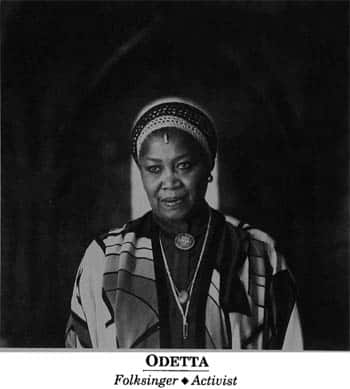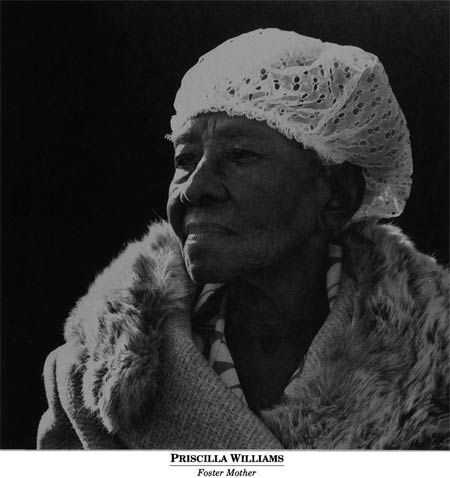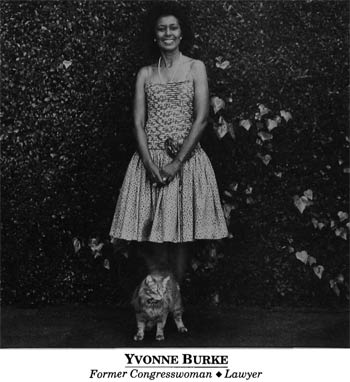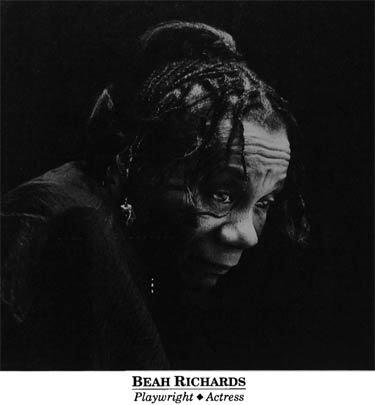by Eleanor J. Bader
| “It’s history we’re viewing and people respond to the photos because the women have had such an impact on the world and on other people” By Eleanor J. Bader; Photos By Brian Lanker |
To some, no doubt, it is sheer fantasy to dream a world free of racism, classism, sexism and heterosexism. But to others it is a way to survive, a way to channel energy, creativity and love into a better tomorrow.

For more than 200 years, American women, men and sometimes even children have dreamed of change, doing the grueling day-to-day organizing to reform the status quo and move our country a tiny bit forward. Some are well-known, like Martin Luther King, Frederick Douglas and Susan B. Anthony; others are all but forgotten by the recorders of history. Still others are remembered only locally, heroines and heroes celebrated for their bravery, audacity and daring, women and men who stood up to the bosses, the Klan and those who would have stopped them from living their lives to the fullest.
They are an awe-inspiring lot, and history – if not the history books – is rife with their example. Now, photographer Brian Lanker, a 1973 Pulitzer prize winner, has added a new chapter to the continuing celebration of people’s struggles for justice. “I Dream A World: Portraits of 75 Black Women Who Changed America” presents a female view of the world as it should be, in their words, accompanied by some of the most beautiful portraits ever taken.
“These women,” says writer Maya Angelou in an introduction to the book which accompanies the exhibit, “have descended from grandmothers and great grandmothers who knew the lash firsthand, and to whom protection was a phantom known of, but seldom experienced…But they are whole women. Their hands have brought children through blood to life, nursed the sick, and folded the winding cloths. Their wombs have held the promise of a race which has proven to each challenging century that despite threat and mayhem it has come to stay. Their feet have trod the shifting swampland of insecurity, yet they have tried to step neatly into the footprints of mothers who went before. They are not apparitions; they are not superwomen. They are not larger than life.”

Or are they? Some, like Josephine Riley Matthews , born on October 3, 1897 in Aiken County, SC, have taken responsibility for the next generation, nurturing rural women through pregnancy and childbirth. A fourth-generation midwife, Matthews boasts the delivery of 1300 babies in her long career, but is equally proud of a personal achievement – she graduated high school in 1974. “Well, the Bible says the strong should bear the infirmities of the weak,” she says. “So the woman is supposed to be the weaker sex, but they sure have to stand up for the men a lot of times. I’ll bet you one thing, if the man had to have the first baby there wouldn’t be but two in the family. Let him have the first one and the woman the next one, and his time wouldn’t come around no more.” In her photo, she is sitting in a rocking chair, placid though obviously tired.
Not so for Myrlie Evers, the first Black woman to become Commissioner of the Board of Public Works in Los Angeles, and the widow of NAACP field secretary Medgar Evers. She stands proud and dignified, poised as she holds the folded flag that graced her slain husband’s casket. “In the barrel of racism, Mississippi was at the bottom,” she says. “I was born there, lived there most of my life, bore my children there, and lost my husband there. I know hatred. I know the bitterness that can envelop body and soul. I know what it’s like to be in court and watch the man accused of murdering your husband and witness the Governor of Mississippi walk in, sit down, shake hands and proudly slap the accused man on the back. You know it when the accused stands before the media and says that he is glad he got rid of varmints.”

“I Dream A World” mixes photos and text from women well-known and unknown, professional and working class. There are musicians and performers: Beah Richards, Marian Anderson, Oprah Winfrey, Leontyne Price, Lena Home, Sarah Vaughn, Odetta and Ruby Dee. And writers like Toni Morrison, Alice Walker, Gwendolyn Brooks and Sonia Sanchez. There are athletes and activists, a Creole chef and an Army Brigadier General. There are high level government officials and grassroots women like Winsom and Dovie Hudson, both of Carthage, MI, who recall bombs being thrown into their home to punish them for attempting to register to vote. Their uncle was hung by the Ku Klux Klan, but “the more they did to us, the meaner we got,” Winson says. “We really taught them some lessons,” Dovie concludes. “I never walked down the hall with a cap and gown on, but I walked down a hall in Washington and I lobbied for student loans, I lobbied for Social Security, and I lobbied for teacher’s pay raises, and I’ve helped you get equal pay right here in the county, so I’m the educator.”
Other activists include Angela Davis, Rosa Parks, Eleanor Holmes Norton, Johnnie Tillmon, Betty Shabazz, Marian Wright Edelman and Septima Poinsette Clark. All are articulate, forceful speakers, and all lambast the double oppression felt by African-American women in the United States.
“I don’t think I really understood the double minority until I read The Color Purple,” Lanker told On the Issues. “I saw myself, a white man, and I realized so much more the oppression that men in general are responsible for.” That insight, coupled with two other events, propelled Lanker to create “I Dream A World.” First, he says, “when Barbara Jordan addressed the Democratic Convention in 1976 she stood up, and I said ‘Where have you been? You’re the one who belongs in the White House.’ Then it dawned on me, she was Black and a woman.” He began to get angry, he says, that “we are taking gifts from people, their skills and expertise, but not giving them full opportunities. “Still, Lanker wondered how Jordan had managed to accomplish so much, how she had overcome obvious race and gender biases to become an impassioned orator and respected firebrand. At the same time, “my wife was always talking about a Black woman who’d been her nanny in Wichita, KS. They had kept track of each other but except for an occasion or two, they had had no physical contact for 15 years. They had exchanged letters and I finally said ‘I think you should fly her out here to get to know the family.’ One visit turned into multiple trips and the contact between her and the children was an incredibly rich experience for all of us.” Although the 41-year-old Lanker has never participated in the civil rights movement, by the mid-1980s the three events had crystallized into a project of tremendous urgency. Priscilla Williams, the nanny, was near 90 (she died several weeks after she was photographed and interviewed), as were several other women Lanker wished to include. “I did not have the luxury of time,” he says. “The National Endowment for the Arts involved too much red tape, so I contacted Eastman Kodak. It happened over a hand shake. I did not need to go through reams of paper. They immediately understood the importance of the project and provided a two-year grant.”

Lanker then set out, tracking down those women he knew he wished to include and doing research to uncover the names and whereabouts of “unsung heroines.” “I don’t believe a photographer is an uninterested observer,” he said. “That’s not the answer to getting at objectivity. You have to be passionately involved in what you’re doing, otherwise, it’s next to impossible to get the viewer involved. In ‘I Dream A World,’ you sit on that woman’s sofa, you make the contact. If I’m going to bring forth the essence of the individual, I have to be involved and committed so that the viewer feels what the interaction is about.”
And we do. The pores of the skin, the threads of a garment, the wrinkles on a face, the eyes, the jewelry, the stance and oft-times majestic bearing, the rocking chair and front porch, all tell us something about the women we are meeting. “This is not my personal journey,” Lanker says. “I feel fine about the photographs. I’ve done much of my greatest work in this show. But it’s history we’re viewing and people respond to the photos because the women have had such an impact on the world and on other people. It’s the women themselves who inspire the response. We need to deal with our history. Fifty, 100 years from now, America will need to know whose shoulders we’ve been standing on.”
THE BRIAN LANKER SHOW
When photographer Brian Lanker worked at the Topeka Capital Journal, his job was to capture “everyday life, the simple ways of simple, real people.” He shot photos of children and the elderly, families in mourning and in celebration, church groups and life on farms. He delighted in meeting people who lived far removed from “drugs, muggings and crime…How often do you see someone who every day separates his cream from his milk just so he can have it on his cereal?” he laughs. “The pages had to be filled. You had to work very fast. I would go from a political meeting to a fire. I was forever going to an assignment where I smelled like a burning house.”

Each assignment, he adds, captured a fleeting moment. “Some were tragic stories. I did it because it was part of the work. So you go to an accident and it doesn’t really hurt until you develop the pictures.”
Then, in January, 1972, he shot the photos that would win him a Pulitzer prize. It began when his acquaintances, Linda and Jerry Coburn, consented to have their child’s birth photographed.
“I was so in awe,” says Lanker, “so excited, so taken with this thing that to this day I can’t remember taking the photographs. What a feat to create a child! No joy can come from a photograph like the joy of giving life itself.”
Although Lanker now lives in Eugene, OR, he is still interested in the nuances of everyday life. In addition to the much heralded “I Dream A World” exhibit, another series of photographs, done in 1983, depicted 1932 Olympic gold medallists, and won him considerable attention. Combining 50 year-old photos with current footage and an interview, the show captured history in a remarkably lively and accessible way.
In addition to speaking engagements which accompany the “I Dream A World” exhibit, Lanker presently works as a freelancer. His work appears regularly in Sports Illustrated and Life Magazine.
As to the future, Lanker is reticent. Although he admits that he will soon “be on to new projects,” it appears that his audience will have to wait for further announcements.
The “I Dream A World” exhibit will tour the country until at least 1992. From February 4 – March 11, 1990 it will be at the Birmingham, AL Museum of Art; From April 8 – June 3, 1990 it will be at the Denver, CO AH Museum; From July 1 August 26, 1990 it will be at the Civic Fine Arts Center in Sioux Falls, SD; From September 23 – November 18, 1990 it will be at the Spencer Museum of Art, University of Kansas in Lawrence, KS. For more information about additional stops on the tour, write the American Federation of Arts, 41 East 65th Street, NY, NY 10021.
